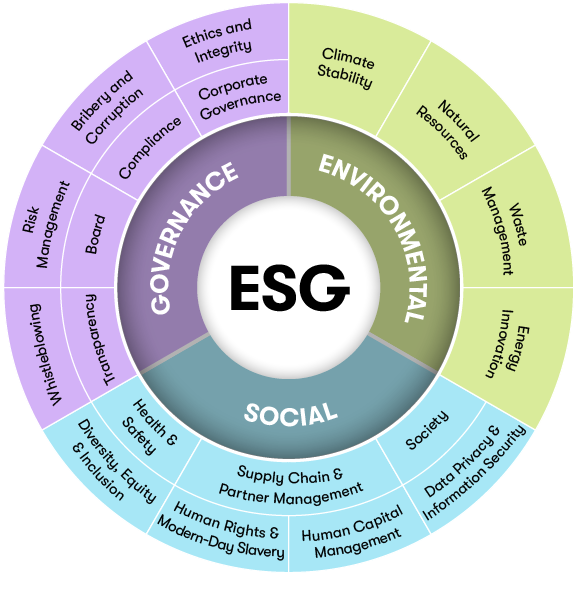檢舉:重新構想您的合規熱線

擁有舉報或合規熱線的公司需要以不同的方式思考他們的系統。在Speeki ,我們也喜歡以不同的方式看待事物。其中一部分涉及透過 ESG 視角看待事物。
雖然ESG的定義不斷變化,但它包括三大類:環境風險、社會風險和治理風險。這三個類別由許多較小的區域組成。
The Speeki ESG Risk Model outlines what we consider these smaller risk areas to be:

透過舉報系統提出的大多數投訴或報告都可以在某種程度上與這些風險領域之一相關。
為什麼將報告與風險領域連結起來?
大多數公司將收到的報告連結到類別。根據報告的位置,這些類別可能與風險類型(如上所述)相關,或可能與將要調查該報告的內部小組相關。對問題進行分類有助於追蹤問題並從中收集資訊。
大多數公司在向管理層或審計委員會報告收到的問題時也會使用這些類別,顯示按地區或每個風險領域收到的報告的詳細圖表。這表明某些問題來自何處以及系統中出現的問題類型。有時,合規或調查團隊會使用此資訊作為可能正在出現趨勢的鬆散指標。
Speeki 將這些趨勢或指標視為“訊號”,並鼓勵公司加強對這些訊號的審查,並真正利用這些數據來分析其風險領域的健康狀況和發展。這可以構成公司自己的 ESG 框架的一部分。
訊號是傳遞某種形式訊息的訊息。一份報告透過Speeki 訊息傳遞(我們稱之為合規或 ESG「舉報」系統)不僅僅是關於事件的報告;當與其他訊號結合時,它是一種訊號,可以識別趨勢、領先指標,或者可能是特定問題偏離其常態的偏離。正是這個元素Speeki 認為大多數合規和 ESG 計劃的服務嚴重不足。雖然在儀表板上將報告分類到風險區域看起來不錯,但如果與其他訊號一起考慮以嘗試繪製趨勢或更大的指標,則更有價值。
我們將報告系統用作訊號的五個最佳實踐
1. 分類
It is essential to categorise the reports into one of the risk areas that you have across your framework. The Speeki ESG Risk Model provides a set of 19 key areas that reports can be categorised to. This classification will link matters across multiple signals and allow you to view a more holistic model.
2. 保持一致
如果您要對報告進行分類,那麼在整個公司使用相同的分類模型並確保所有標籤保持一致非常重要。如果沒有這一點,以有意義的方式將資訊整合在一起並連結訊號將非常具有挑戰性。這就是為什麼我們採用Speeki ESG 風險模型 – 這是我們對 ESG 的含義以及它如何為我們發揮作用的「根基」。
3.連結其他訊號
一旦有了映射資訊的通用框架,開始擴展資訊量就很重要了。這Speeki 平台著重於多種訊號:一是報告系統,但其他可能是對話、聲明、揭露、計畫審查、差距分析、調查報告、離職面談和調查。所有這些訊號以及許多其他訊號可以一起使用,從已識別的「基礎」位置得出推論、趨勢和漂移。
4. 超越調查思考
當問題被報告時,通常會進行一系列活動來調查並找出指控或報告的真相。這完全是預料之中的事情,並且應該成為一個主要焦點。 However, as you are working through the specific issues raised by the report, it is essential that you also firmly focus on building up other signals that can be used in a broader assessment of the root cause of the issue and how it relates to your risk程式.並非總是能夠立即確定特定問題的根本原因,但您可以使用其他訊號和相鄰風險區域的資料來進行根本原因評估。正是這些額外的數據使您能夠開始了解趨勢,並最終不僅針對根本原因,而且還針對阻止問題再次發生的最佳行動方案做出明智的決定。
5.利用專業知識和技術來識別和預測未來的問題
It would be great if a piece of technology like the Speeki Platform could just absorb all the data from the signals and miraculously and accurately predict the next issue. That is certainly the direction that Speeki is heading in, but it is unreasonable to assume that something like that will be fully operational within the next few years at least. The inability to have a perfect prediction model is more an issue with the amount of data needed to predict issues accurately than a technology issue (most of the technology is already around to do that prediction). In the meantime, it comes down to getting the data right through having lots of signals activated across multiple risk areas and having that data accurately categorised according to your risk model (in our case the Speeki ESG Risk Model). Once you have the signals producing information, you can start to fill the time gap with human experience, leveraging the knowledge and skills of experts in risk and ESG to look at the data and start to draw conclusions.
您的舉報或合規熱線不僅僅是一個投訴或舉報的機制;這是對貴公司不斷變化的健康狀況的審視。
透過關鍵風險領域的訊號收集資料的能力對於預測和管理整個公司的 ESG 風險至關重要。
Drawing on the Speeki Platform to build strong ESG practices can transform a whistleblower report on a discrete issue into a signal that points towards a trend of increased risk, allowing you to predict and manage these risks for the benefit of your company and its stakeholders.




